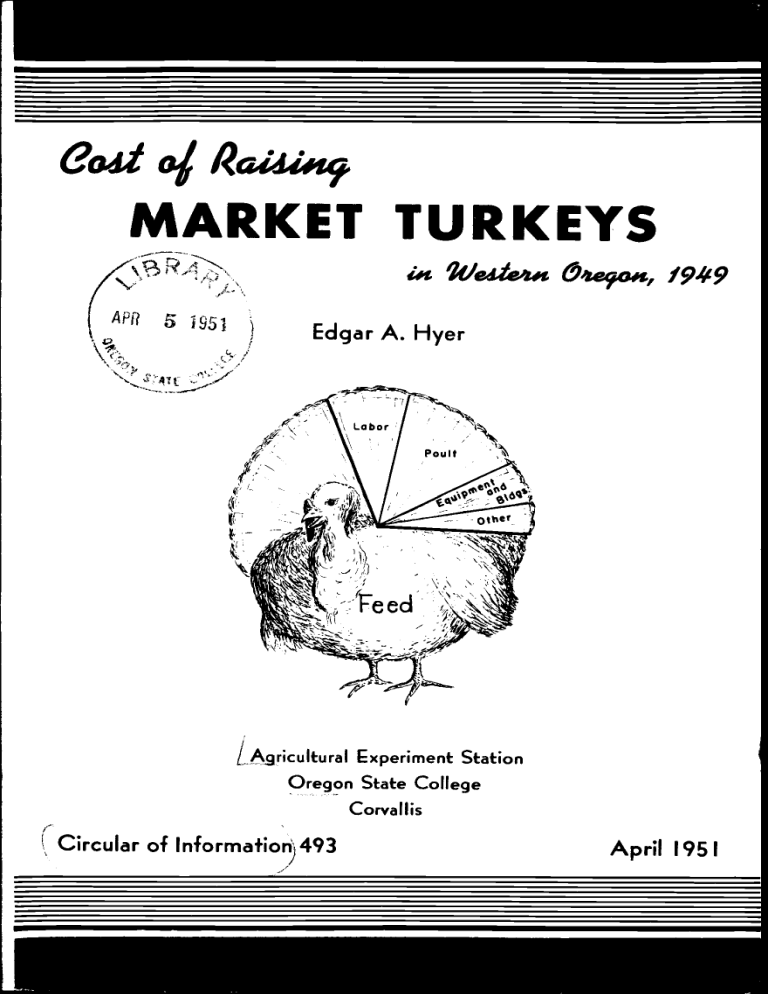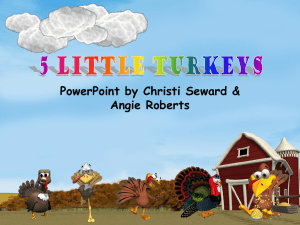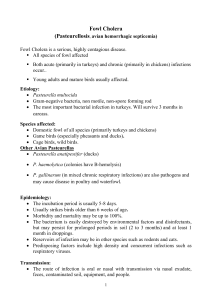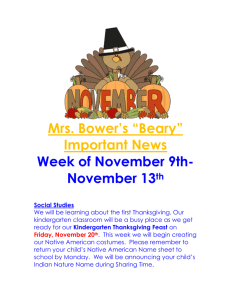MARKET TURKEYS I eesIe/Rais /Y

eesIe/Rais
MARKET TURKEYS
i#i
Wesie##t &e9o#t, 1949
API?
5
951
Edgar A. Hyer
I
__\
-n-'
/Y
\Labor/
Poult
othef
Ld../gricultural Experiment Station
Oregon State College
Corval I is
(Circular of lnformafioñ493
April 1951
Cost of Raising Market Turkeys
't
bWeSIe O4e9O.t, 1949
Edgar A. Hyer
Assistant Agricultural Economist
This report summarizes basic information on the costs and returns from market turkeys in Western Oregon for
1949.
All flocks included in this report were Broad-Breasted Bronze turkeys.
Cosf of Raising Turkeys
On the whole, the year
1949 was not favorable for the production of turkeys in Oregon.
When all costs had been considered, including an allowance for operator and family labor, interest on investment, depreciation on buildings and equipment, costs exceeded returns by about 25 cents per bird.
Some producers, however, did not raise turkeys at a loss.
The 10 most profitable flocks were raised at a profit of $1.10 per bird.
The 10 least profitable flocks were raised at a loss of
$1.69
per bird.
The explanation for this wide variation awaits further analysis.
Item
Table 1.
COST OF RAISING MARKET TURKEYS IN WESTERN OREGON,
1949
Cost per turkey raised
Bought as day old
Started or custom brood_e4_
Number of flocks
Number of birds raised per flock
79
2,655
8
3,233
Labor
Feed
Poults
$
.63
4.79
.98
Equipment and building ............
.33
Miscellaneous
.28
Total cost per bird
Less manure credits
Net cost per bird
Total returns per bird
Net profit per bird
$'7.0l
.06
$6.95
6.69
$-.26
Net profit per bird, all flocks*
Cost per pound of gain, all flocks* ...........
Total returns per pound of gain, all flocks* ......
37.7
37.3y
$
.37
4.23
1.90
.15
.21
$6.86
.06
$6.80
6.68
*Includes 2 mixed flocks (some birds day old and some started)
2
The labor, feed, building, and equipment expenses were less for started and custom-brooded turkeys than for turkeys bought one day old, since the operators did not have these birds during the brooding period.
Brooding fees and higher poult costs were found for these flocks.
Both types of flocks were about equally profitable.
Mortality of Birds
cent.
The mortality of flocks kept from one day old until raised was 14.7 per
An average of 8.6 per cent of the birds were lost in brooding and 6.1
per cent were lost while on the range.
These losses compare favorably with those reporteI by studies in other areas of the United States.
Table 2.
Period of raising
MORTALITY OF TURKEYS RAISED IN WESTERN OREGON, 1949
(79 Flocks_Bought_at_One Day_Old)
Mortality rate
Per cent
Brooding
Onrange
8.6
6.1
Total mortality ....................... 14.7
Labor Requfrements
One man can care for a large flock of turkeys.
On an average only 0.6
hour of labor was spent per bird in raising a turkey from one day old to market age.
Nearly one-third of this time was spent in brooding the poults, half of it was spent during the time the poults were on the range, and 17 per cent was spent as indirect labor, that is, labor of an overhead nature that was scattered throughout both periods.
Table 3.
LABOR REQUIRENENT FOR TURKEYS RAISED IN WESTERN OREGON, 1949
(79 Flocks Bought as One Day Old)
Period of rais
I
ILabor required
Per 1.000
Per bird birds raised
Man hours raised
Man hours
Pronortion of labor
Per cent
Brooding ..........
On range
..........
Indirect labor*
Total labor
......
196
312
101
609
.20
.31
.10
.61
32
5
17
100
*Estimated labor unaccounted for in regular duties such as: occasional checking of birds at night, attending producer meetings, consulting with buyers and feed dealers, keeping records, etc.
3
Only a small proportion of the labor was hired on two-thirds of the flocks and there was considerable hired labor for one-fifth of the flocks.
The average value placed by operators on their own labor was $1.10 per hour.
Operator labor on all flocks was charged at this rate.
Hired labor was charged with the actual wages paid.
Farmers who bought started or custombrooded turkeys, of course, had lower labor expenses.
Table 4.
Kind of labor
COST OF LABOR FOR TURKEYS RAISED IN WESTERN OREGON,
1949
Day old
Labor per bird
Cost per bird
Man hours
Started or custom broode
Labor per bird
Nan hours
Cost per bird
Operator, direct
.
Operator, indirect
.
.11
Family labor .......
.07
Hired labor .......
.12
Total
.
.31
.61
$
.34
.12
.07
.10
$
.63
.14
.03
.05
.12
.34
$
.15
.03
.05
.14
$
.37
Cost per hour of labor $1.03
$1.09
Sex of Turkeys
Most flocks were straight-run, that is, there was no selection of one sex over another.
In 11 of the 89 flocks, however, a high percentage of the birds were hens.
Two flocks were predominately toms.
Sex
Hens
Toms
Unknown
Table 5.
DISTRIBUTION OF TURKEYS RAISED BY SEX
(89 Flocks in Western Oregon, 1949)
Average number in flock
Proportion
_of total
Per cent
Number of flocks that were 70 per cent or more of one sex
1,464
1,268
22
Total ......
2,754
54
46
---
100
11
2
--
4
Feed cost.
Sicty-eight per cent of the total cost of producing turkeys was feed
An average of 40.2 pounds of scratch feed was consumed per turkey raised and 67.4 pounds of mash and pellets.
A total of 107.6 pounds of these feeds per bird raised was consumed.
Farmers who bought turkeys already brooded fed about 12 pounds less feed.
Wheat and corn were the most common scratch grains fed.
100 pounds.
The average price for all scratch feed was $3.25 per
It was $4.80 per hundred pounds for mashes and pellets.
As a rule, ranges supplied little feed.
Feed
Table 6.
A1'IOUNT AND COST OF FEED FED PER TURKEY RAISED
(1 rri from
IN WESTERN OREGON, 1949
Q Fl oaks Fed from One flay Old to Market Ape'
Feed per bird
Pounds
Cost of feed
Wheat ................
13.4
$ .48
Corn 11.0
.36
.20
Oats
Barley
7.0
1.7
1.2
Speltz
Mixed scratch 1.3
Other ................
4.6
All scratch .............
40.2
All mash and pellets ........
67.4
.05
.03
.05
.14
$1.31
3.24
All scratch, mash and pellets
.
.
107.6*
$4.55
Supplemental feed, grit and range . 24_
Total cost ..............
$4.79
Proportion of cost
Per cent
10
1
1
7
4
1
3
27
68
95
5
100
Price per
100 pounds of feed
$ 3.58
3.25
2.83
2.90
2.72
4.20
3.16
$ 3.25
4.80
$ 4.21
*Total pounds of feed for started or custum-brooded birds - 95.6.
Age of Turkeys at Time of Market
Twenty-eight weeks (196 days) was a common growing period for turkeys.
Hens were sold a little earlier than toms and breeders were separated a little earlier than market birds.
Table 7.
AVERAGE AGE OF TURKEYS AT TINE SOLD
AND AGE OF BREEDERS AT TINE SEPARATED
(86 Flocks in Western Ore2on. l9L9)
Class of birds Hens
Days
Average age of birds*
Toms
Days
Breeders .................... 192
Narketbirds .................. 193
196
20L
*196 days equal 28 weeks or 7 months.
5
Weights of Birds at Market
The average dressed weight of hens was 13.9 pounds per bird.
Tonis averaged about 10 pounds heavier than hens.
The birds were New York dressed, that is, feathers and blood only were removed.
The average gain was a little less than 0.1 pound per day.
Tonis gained at a faster rate and hens gained at a slower rate.
The higher grade birds weighed a little more than the lower grade birds in both sexes.
Table 8.
AVERAGE WEIGHT AND GAIN PER DAY OF TURKEYS
(85 Flocks in Western Oregon, 1949)
Sex
Average dressed weight of turkeys
Pounds
Hens ................ 13.9
Toms ................ 24.2
Alibirds .......... 18.4
Gain per turkey per day
Pounds
073
.119
094
Grade
Breeders*
GradeA
....................
.....................
GradeB
GradeC
.....................
.....................
Undergrade
All turkeys
Table 9.
AVERAGE WEIGHTS OF TURKEYS BY GRADES
(88 Flocks in Western Oregon, 1949)
Average dressed weights
Hens Toms
Pounds Pounds
14.0
13.
13.5
12.7
12.9
13.9
25.1
24.5
23.3
21.7
19.2
24.2
*Dressed weight equivalent
Grade of Birds
Nany of the turkeys raised in Western Oregon are used for producing hatching eggs.
An average of one-third of the hens in each flock were raised for breeders.
Since a siraller proportion of the large flocks were kept for breeders, a little less than one-third (29 per cent) of all the hens in the study were kept or sold as breeders.
A much smaller percentage of the toms were kept as breeders.
Breeder grade requirements are high.
Combining the breeder and Grade A grades together shows 92 per cent of the hens and 82 per cent of the toms at top grade.
Table 10.
DISTRIBUTION OF TURKEYS BY GRADE
(88 Flocks in Western Oregon. 1949)
Birds
Grade
Per cent
Breeders
GradeA
58)
GradeB
GradeC ....................
2
5
Undergrade and others .............
1
2
Total .................. 1100
Toms
Per cent
782
100
Prices Received
The average New York dressed price received for hens was 44.6 cents per pound compared with 30.3 cents per pound for toms.
Using average prices and weights, the average return for hens was $6.20 per bird compared with $7.33
for toms.
A common buyer practice was to pay 3 cents less per pound for Grade
B hens and toms than for Grade A, to pay 7 cents less for Grade C hens than
Grade B, and pay 5 cents less for Grade C torns than Grade B.
Typically, breeders were sold at Grade A price on their live weight.
This meant that breeders sold for a premium of about 10 per cent over Grade A birds.
Grade
Table 11.
DRESSED PRICES RECEIVED AND VALUES FOR TURKEYS BY GRADE*
(88 Flocks in Western Oregon, 1949)
Price per pound (dressed)
Hens
Cents
Tonis
Cents
Breederst
GradeA
48.1
43.7
Grade B 40.4
Grade C .....................
33.1
Undergrade ...................
15.3
Average .................
I
Value per bird (using average weights and prices) $6.20
33.6
30.9
27.7
22.3
1 /
.L) .L,
30.3
$7.33
*Net price to farmer.
Buyer pays for hauling, killing, processing.
tBreeder price reduced to dressed weight equivalent.






